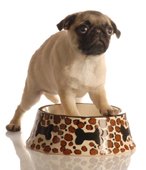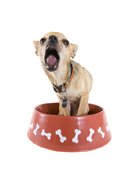 |
 | 
| |
Housebreaking a PuppyOr Think of it as Potty Training PuppiesHousebreaking a puppy needs to happen early in its life. Housebreaking puppies is also known as potty training puppies. Successfully potty training a puppy requires patience and structure. House breaking a puppy can be very challenging especially for people who have day jobs. So what are the best methods for housebreaking puppies? The answer to that question depends a bit on your circumstances at home, but one of the key components to potty training a puppy is patience and consistency. If youre rarely home, be ready for a very long haul (and a puppy may not be your best choice in pets). If you have friends or family who can help, however, then you can create a plan. Guidelines for Housebreaking a PuppyBe aware from the get-go that your puppy is going to make a mistake. Potty training a puppy is similar to working with a child except it takes less time! If you do not SEE your puppy make a mistake you should not punish him or her. They will have no idea why youre mad. Having said that, its just as important to remember to praise your puppy when they do a good job with training. Dogs are very social creatures. They understand your tones and the simple words when repeated in specific circumstances. Yes! No! Good! Hurry Up! Keep it simple and unfailing. Housebreaking a puppy is often a learning experience for both the puppy and you (you'll learn a lot about your pup while you go through the experience). Housebreaking Puppies - MethodWhile you can use newspaper and praise your pup when he or she uses the right spot, this sends a mixed message to your dog - is it or is it NOT ok to eliminate in the house? If your goal is getting the dog outside, paper training may not be your best option. The method recommended by most dog trainers is crate training. If you pick a crate just big enough for the dog to turn around in, then they wont eliminate in the crate because they like clean living spaces. Note that if your crate is too big, it may encourage the dog to eliminate in the open spot where they wont sleep. Now, it's very important that you dont abuse the crate. When sleeping, puppies are ok for 7-8 hours, but beyond that it will be very hard for them to hold it. When awake and active, you can anticipate the dog being able to control elimination for one hour per month of age. If you know you cant observe your pup, put him in the crate with a little treat. Make that his or her 'special' place. A toy in the crate is good too. When you can go back to being attentive, take the dog right outside, reward good behavior (the reward doesn't have to be dog treats, it can praise or play), then return to the house. Some people feel awkward or bad about crate training (thinking that 'caging is bad'), but its something thats good for your dog. In the wild, pups seek out caves for a safe space. The crate becomes an alternative safe space in the house that youll find your dog goes to naturally even when you dont put them inside. The Importance of Verbal Cues in Potty Training PuppiesWhen you are housebreaking a puppy don't overlook the importance of verbal cues. For example, the term 'out' or 'outside' is a great verbal cue for your dog. If you use it at the door every time you take them out, theyll quickly realize the meaning. If you have a dog that refuses to bark to go out, you can watch for physical signs (like circling) or you can create a game for the pup. For example, put a set of bells on the door knob for the dog to paw instead of barking. It works wonderfully. Summary: Effectively Potty Training a PuppyBy following these basic guidelines youll find that housebreaking a puppy isnt as difficult as you may have imagined. Remember it's all about building a trusting relationship with your dog and giving them consistent input and structure (take them out every hour, then every two hours, and so on - and also take them out the same door each time. Within about 4-6 weeks, you should see some level of success that both you and your dog can celebrate. P.S. Taking care of your puppy also includes making sure that your puppy is well cared for. Check ears, eyes, skin and coat regularly - they reflect the health of your pup. Make sure that you get the required vaccinations for your dog - visit your veterinarian. Also make sure that if your puppy spends time outside playing in the grass and dirt and with other dogs that you use a preventative flea shampoo that is not hard on your pet's skin. We recommend PetAlive BeFree Flea Shampoo for Dogs: it helps deter fleas, flies and mosquitoes. Return to top of Housebreaking a Puppy. Return to The Dog Biscuit Home Page. | Related Articles
Each of these articles provides you with puppy information.
New Puppy Care Pet vaccines, neutering/spaying, check-ups, and more. How to Train a Puppy? Puppy training 101. House Training a Puppy Successfully training your new puppy - it's possible! Housebreaking a Puppy Your puppy needs to learn; housebreaking. Puppy Teeth: Dental Care Chewing and biting are normal symptoms of teething. Puppy Weight Estimates Are you able to estimate the potential weight of your pup at full growth? Puppy Worms: Treat Early Your pup's health is important; be aware of sick puppy symptoms and causes.    | ||
|
Enjoy This Site?
Then why not use the button below, to add us to your favorite bookmarking service? | |||
|
| Home | About
| Contact | Sitemap
| What's New
|Privacy Policy |
This site is for informational purposes only. If you have an issue with your dog's health, please see your vet.
Website design by Webmidwife.com | |||
| | |||







